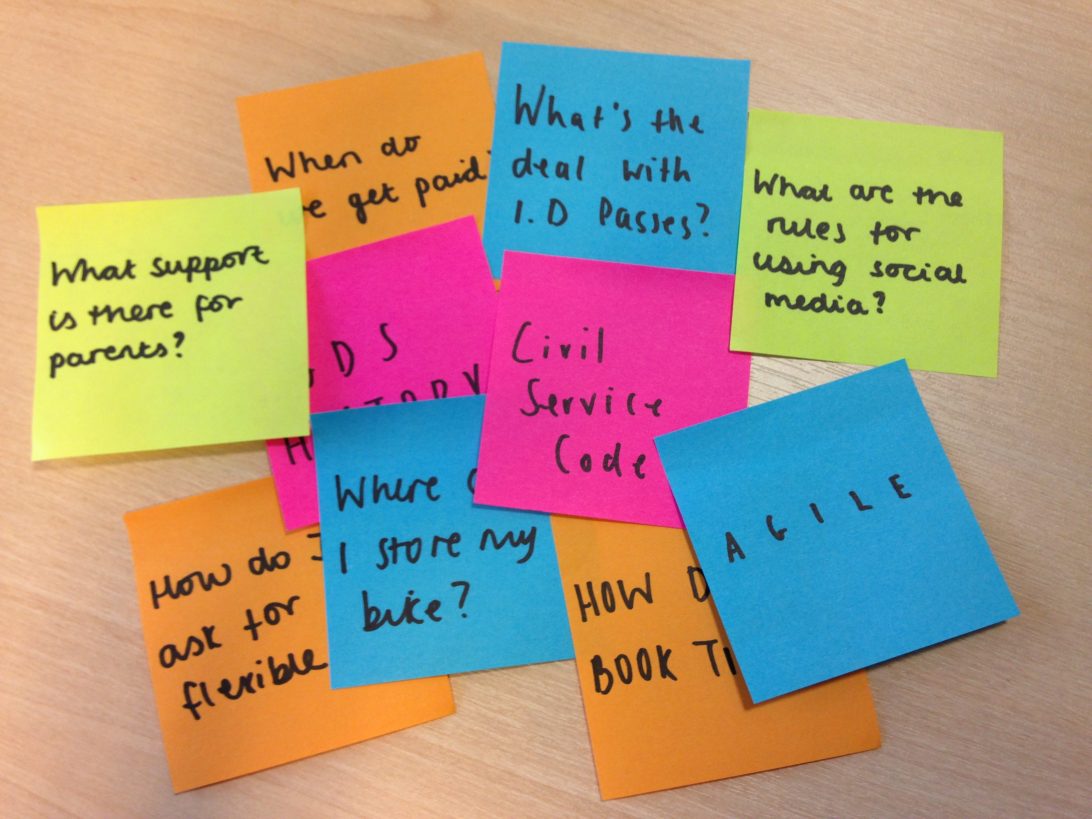
A good induction should feel like checking into a beautifully designed 5-star hotel. You should be greeted on arrival and someone should be there to pre-empt any questions. They should relay essential information (like where breakfast is served) in a direct but not-too-pushy tone. They should probably give you champagne.
The GDS induction came up at a line manager and community leads workshop held in April.
The workshop attendees split into groups. Each group identified a problem they had experienced during the hiring or line-management process. There were quite a few things that we needed to fix with the induction process, so one group decided to look at inductions in more detail.
Why the GDS induction process wasn’t 5-star
A combination of rapid hiring and too few induction sessions to meet such a high level of demand had led to a backlog. This meant that the induction happened too long after a person started.
The content wasn’t relevant to all new starters.
Signposting to online employee content needed improving too. We should do the hard work to make it easy for new starters to get to grips with their new workplace.
The quality of an induction also depended on the team you were in and how much effort they put into it.
What a good induction looks like
During the workshop, one group came up with ideas for what an ideal induction should look like.
The guiding themes were frequency, consistency and clarity.
Approximately 45 new employees join each month. To avoid a backlog, induction sessions should happen every week. As many people as possible should be able to give the presentation and welcome new staff.
Inductions should be consistent in content, regardless of the team a person works in. They should be clear and concise.
The ideas from the workshop informed the new induction process.

Making things better
The subject of the GDS induction had been raised separately with the People Board quite a few times.
The People Board is an elected body that exists to make GDS a better place to work. With support from the People Board, the Creative team offered to work with the People team (which deals with recruitment, training and development) on a revamped induction.
Those 2 teams ran an informal workshop, and wrote down all the things that new starters should know about - one per sticky note. Then they sorted those stickies into 2 piles: the stuff you have to know, and the stuff it’s nice to know.
The new induction treats each of those in a different way.
The stuff that it’s nice to know has become a presentation, which we’re iterating and improving every time we give it. Soon it will be happening every week, and the goal is that we never have a backlog of un-inducted people. The presentation includes what GDS does and how it does it, when payday is and the culture of the organisation.
The stuff you have to know has become a Trello board. Newcomers receive a link to it and are asked to make their own copy. Then they work through the cards on that board during their first week or so, learning as they go. Trello is a digital to-do list, with each task listed on an individual card. Each card gives a few lines of explanation or links to the source of appropriate information. Trello was already used by a number of teams, including GOV.UK.
The new induction, like any GDS product should be iterated and improved. Now we're trying to welcome contractors like we do full-time members of staff. If you’re a new starter and you’ve been through the new induction recently, we want to hear what you think: email the People Team.



2 comments
Comment by Nathan McIntosh posted on
This is great folks, we're wrestling with our own induction process too. Trello board is an interesting idea. Is part of the induction process centralised by a People & Capability or HR function?
The biggest sticking point we often encounter is machines and access. Often people can't really start because they have to be in the building before we can really sort their access out.
Part of our process gets people updating our internal wiki with stuff that's not quite accurate. 🙂
Comment by raghu posted on
Induction training must include the following elements:
General training relating to the organisation, including values and philosophy as well as structure and history, etc.
Mandatory training relating to health and safety and other essential or legal areas.
Job training relating to the role that the new starter will be performing.
Training evaluation, entailing confirmation of understanding, and feedback about the quality and response to the training.